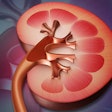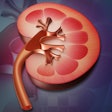
A research team at the University of Tokyo has developed a proof-of-concept method for the early detection of chronic kidney disease (CKD) in pediatric patients, according to a study published on Tuesday in iScience.
Childhood CKD leads to substantial morbidity and mortality, as well as diverse medical issues beyond childhood, making it a focus of research into early detection methods, the team wrote.
CKD stems from a variety of pathological conditions and develops when nephrons in the kidney are damaged. Damage may come from lifestyle, inherited and congenital diseases, or injury; damaged nephrons cannot be completely regenerated without difficulty.
While urine and blood tests can determine if a patient has suffered kidney damage, they “may miss the early stages of nephron loss because of compensatory growth and hyperfunction of remaining nephrons,” the researchers wrote.
“Conventional urine tests may miss certain forms of CKD,” Yutaka Harita, study coauthor and associate professor at the University of Tokyo Graduate School of Medicine, said in an email interview. “Dilute urine caused by decreased concentration capacity in some forms of CKD also makes it challenging to detect abnormality.”
The proof-of-concept test seeks to address some of these challenges.
“The new test can be used in conjunction with existing methods for early detection in health screening,” Harita added.
The team analyzed urine extracellular vesicles (uEVs) in the urine samples of the study cohort. The uEVs contain cell-specific proteins from nephron segments and function as a source of urinary biomarkers for determining the pathological conditions in the kidney and urinary tract, the team said.
The researchers collected samples from children with and without CKD. Of the overall cohort, 26 children had healthy kidneys; 94 suffered mainly from congenital anomalies of the kidney and urinary tract (CAKUT). None of the children had diabetes or diabetic kidney disease.
The team employed a Tim4-based purification system to extract uEVs. Protein composition in uEVs was analyzed using liquid chromatography-tandem mass spectrometry.
The team then quantified MUC1, MGAM, CD9, and CD63 levels in uEVs using an enzyme-linked immunoassay (ELISA) system.
“We applied differential enrichment analysis by protein-wise linear models combined with empirical Bayesian statistics to identify the proteins that best-distinguished samples from patients with renal hypoplasia and healthy controls,” the authors wrote in the study.
“It revealed a total of 135 discriminatory proteins, among which 35 and 100 proteins were increased and decreased, respectively, in renal hypoplasia,” they added.
MUC1, for example, experienced a decreased expression in uEVs, implying decreased excretion of classical exosome because of functional nephron loss, the authors said. CD9 also significantly decreased in CKD patients.
The authors noted several limitations of the study.
“First, it remains unclear whether the signature using Tim4-purified samples … are equally applicable to uEVs purified by other methods,” they wrote.
The authors also could not clarify the correlation between uEV characteristics and pathological changes, due to most of the diseases in this study (e.g., renal hypoplasia) not being histologically diagnosed.
Furthermore, a normalization strategy for quantitative proteome analysis for human body fluids has yet to be established, the team said. While the study applied total protein amount as its normalizing variable, the researchers suggest using other standardization methods, such as urine creatinine, for future studies.
Nonetheless, the findings demonstrate that the “uEVs signature has significant potential as a none-invasive tool for diagnosing kidney diseases,” the authors wrote.
The team plans to create a diagnostic test for CKD using their findings. “We plan to validate through a prospective larger-scale study, which may take a few years,” Harita said.



















